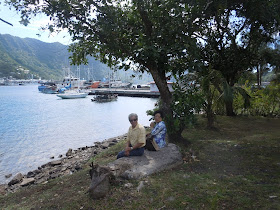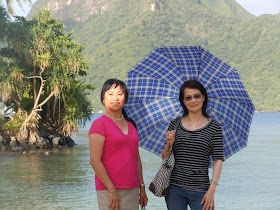Pago-Pago ( American Samoa)












Chợ Pago pago


nhìn cách trang hoàng trong xe buýt





 mời nghỉ chân uống nước dừa
mời nghỉ chân uống nước dừa ăn thêm đu đủ thì tuyệt
ăn thêm đu đủ thì tuyệttrên đường ra bãi tắm
 có muốn tắm không ? nước ấm lắm
có muốn tắm không ? nước ấm lắm dơi (bat) ngủ trên cây
dơi (bat) ngủ trên cây*****************************
From Wikipedia, the free encyclopedia
| Pago Pago | |
|---|---|
![A portion of the docks at Fagatogo in Pago Pago Harbor. In the background is the Rainmaker (Pioa) Mountain. Fagatogo was struck by a tsunami on 29 September 2009, causing moderate damage and rock slides.[1]](https://upload.wikimedia.org/wikipedia/commons/thumb/a/a6/PagoPago_Harbor_NPS.jpg/250px-PagoPago_Harbor_NPS.jpg)
A portion of the docks at Fagatogo in Pago Pago Harbor. In the background is the Rainmaker (Pioa) Mountain. Fagatogo was struck by a tsunami on 29 September 2009, causing moderate damage and rock slides.[1]
|
|
| Coordinates: 14°16′46″S 170°42′02″W | |
| Country | United States |
| Territory | American Samoa |
| Elevation | 30 ft (9 m) |
| Population (2010) | |
| • Total | 3,656 |
| Time zone | Samoa Time Zone (UTC-11) |
| ZIP code | 96799[2] |
| Area code(s) | +1 684 |
| GNIS feature ID | 1389119[3] |
| Website | www.pagopago.com |
Contents
History
From 1878 to 1951, the area was the site of a coaling and repair station for the U.S. Navy, known then as United States Naval Station Tutuila.In January 1942 Pago Pago Harbor was shelled by a Japanese submarine, but this remained the only battle action on the islands during World War II.[citation needed]
On September 29, 2009, an earthquake struck in the South Pacific, near Samoa and American Samoa, sending a tsunami into Pago Pago and surrounding areas. The tsunami caused moderate to severe damage to villages, buildings and vehicles and caused an unknown number of deaths.[1][4]
Geography
The village is located in Pago Pago Harbor, on the island of Tutuila. Pago Pago is one of the many villages in the Urban agglomeration of Pago Pago along the shore of Pago Pago Harbor located at the very eastern part (inside) of the embayment. The area includes a number of villages, among them Fagatogo, the legislative and judicial area, and Utulei, the executive area.[5]However, because the name Pago Pago is associated with the harbor itself—the only significant port of call in American Samoa—Pago Pago is now generally applied not only to the village itself, but to the whole harbor area and to the villages in it.[citation needed] It is in this sense that Pago Pago becomes the de facto capital town of American Samoa.[citation needed]
Both the port itself and the legislature of American Samoa—known as the "Fono" (/ˈfono/)—are in Fagatogo, a village adjacent to Pago Pago. Similarly, the once famous Rainmaker Hotel (now closed) is in the village of Utule‘i, adjacent to Fagatogo along the south shore of the long harbor. The canneries are in Atu'u, on the harbor's north shore. It is suggested that one must avoid eating any fish or invertebrate caught in Pago Pago Harbor because they are contaminated with heavy metals and other pollutants.[6]
Pago Pago is a mixture of semi-urban communities, a small town, tuna canneries, which provide employment for a third of the population of Tutuila, and a harbor surrounded by dramatic cliffs, which plunge almost straight into the sea. A climb to the summit of Mt. Alava in the National Park of American Samoa provides a bird's-eye view of the harbor and town.[7]
-
A statue of Starkist Tuna mascot Charlie the Tuna at the company cannery in Atu'u, Pago Pago, American Samoa.
Climate
Pago Pago has a tropical rainforest (Köppen climate classification Af) climate. All official climate records for American Samoa are at kept at Pago Pago. The hottest temperature ever recorded was 99 °F (37 °C) on February 22, 1958. Conversely, the lowest temperature on record was 59 °F (15 °C) on October 10, 1964. [8]| Month | Jan | Feb | Mar | Apr | May | Jun | Jul | Aug | Sep | Oct | Nov | Dec | Year |
|---|---|---|---|---|---|---|---|---|---|---|---|---|---|
| Record high °F (°C) | 95 (35) |
99 (37) |
95 (35) |
95 (35) |
93 (34) |
95 (35) |
91 (33) |
92 (33) |
92 (33) |
94 (34) |
95 (35) |
94 (34) |
99 (37) |
| Average high °F (°C) | 87.6 (30.9) |
88.0 (31.1) |
88.1 (31.2) |
87.5 (30.8) |
86.2 (30.1) |
85.0 (29.4) |
84.2 (29) |
84.3 (29.1) |
85.3 (29.6) |
85.8 (29.9) |
86.6 (30.3) |
87.4 (30.8) |
86.3 (30.2) |
| Daily mean °F (°C) | 82.6 (28.1) |
82.9 (28.3) |
82.9 (28.3) |
82.5 (28.1) |
81.8 (27.7) |
81.1 (27.3) |
80.4 (26.9) |
80.4 (26.9) |
81.1 (27.3) |
81.5 (27.5) |
82.1 (27.8) |
82.5 (28.1) |
81.82 (27.69) |
| Average low °F (°C) | 77.6 (25.3) |
77.7 (25.4) |
77.8 (25.4) |
77.6 (25.3) |
77.5 (25.3) |
77.1 (25.1) |
76.6 (24.8) |
76.5 (24.7) |
76.9 (24.9) |
77.2 (25.1) |
77.5 (25.3) |
77.6 (25.3) |
77.3 (25.2) |
| Record low °F (°C) | 67 (19) |
65 (18) |
63 (17) |
68 (20) |
65 (18) |
61 (16) |
62 (17) |
60 (16) |
62 (17) |
59 (15) |
60 (16) |
65 (18) |
59 (15) |
| Average precipitation inches (mm) | 14.83 (376.7) |
12.66 (321.6) |
11.66 (296.2) |
11.02 (279.9) |
10.61 (269.5) |
6.01 (152.7) |
6.46 (164.1) |
6.30 (160) |
7.62 (193.5) |
10.11 (256.8) |
11.30 (287) |
14.51 (368.6) |
123.09 (3,126.5) |
| Average precipitation days (≥ 0.01 in) | 24.0 | 21.4 | 23.8 | 22.1 | 20.1 | 19.1 | 19.3 | 17.8 | 17.9 | 20.9 | 20.8 | 23.1 | 250.2 |
| Source: NOAA (normals)[8] | |||||||||||||
Education
The Feleti Barstow Public Library is located in Pago Pago.[9] In 1991, Severe Tropical Cyclone Val hit Pago Pago, destroying the library that existed there. The current Barstow library, constructed in 1998, opened on April 17, 2000.[10]Tourism
Until 1980, one could experience the view of Mt. Avala by taking an aerial tramway over the harbor, but on April 17 of that year a U.S. Navy plane, flying overhead as part of the Flag Day celebrations, struck the cable; the plane crashed into a wing of the Rainmaker Hotel.[11] The tramway was repaired, but closed not long after. The tram remains unusable, although according to Lonely Planet, plans have been put forth to reopen it, but in December 2010 the cable was damaged by Tropical Cyclone Wilma, fell into the harbor and has not been repaired. Another noted view is that from the top of the pass above Aua Village on the road to Afono.[citation needed]The Sadie Thompson Building, on the outskirts of Pago Pago, is a restaurant and inn that is listed on the U.S. National Register of Historic Places.
See also
References
- Moos, Grant. 1980 [1997]. "April 17, 1980: Fiery crash halts Flag Day". Samoa News, April 18, 1980 (reprinted in the Samoa News, January 22, 1997: 4). Cited in Sorensen, Stan, and Joseph Theroux. The Samoan Historical Calendar, 1606–2007. p. 93.
External links
- Pago Pago, American Samoa National Weather Service Office
- Pago Pago Weather underground
- Census-2010 Population
Samoa American 2011
Văn Lành thực hiện









































Aucun commentaire:
Enregistrer un commentaire